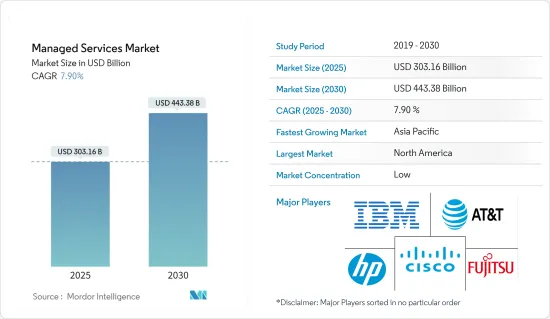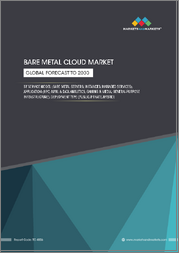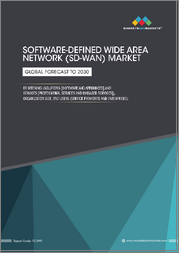
|
시장보고서
상품코드
1686521
매니지드 서비스 - 시장 점유율 분석, 산업 동향, 통계, 성장 예측(2025-2030년)Managed Services - Market Share Analysis, Industry Trends & Statistics, Growth Forecasts (2025 - 2030) |
||||||
매니지드 서비스 시장 규모는 2025년에 3,031억 6,000만 달러, 2030년에는 4,433억 8,000만 달러에 이를 것으로 예측되며, 예측 기간(2025년-2030년) CAGR은 7.9%를 나타낼 전망입니다.

비중핵 업무의 아웃소싱을 검토하는 중소기업이 늘어나고 있으며 중견 및 중소기업(SMB)이 시장 성장에 긍정적인 영향을 미치는 원동력이 될 것으로 예상됩니다. 그리고 MSP의 평균 고객수는 122개사로 MSP 고객의 약 60%는 직원 수 1-150명입니다.
주요 하이라이트
- 매니지드 서비스에는 다양한 이점이 있으며, 서비스를 도입한 조직은 핵심 전문 지식에 집중할 수 있기 때문에 개발에 긍정적인 영향을 미치는 것으로 입증되었습니다. 무효율을 45-65% 향상시킬 수 있다고 추정되고 있습니다.
- 게다가 2022년에는 개발 속도에 맞는 용도의 배포가 중요해질 것으로 예상되었습니다. 탈링(사용자 행동 조사), ADTD(애플리케이션 발견, 추적, 진단) 및 AIOps 분석(애플리케이션 라이프사이클 패턴 및 비정상 감지)은 모두 APM의 일부가 됩니다.
- 업계의 요구사항, 표준, 소비자의 요구가 날마다 변화하는 가운데, 기업은 결과에 근거한 성과를 요구하고 있습니다.
- 게다가 블록체인과 IoT 기술은 매니지드 서비스 제공업체에게 보다 좋은 기회를 창출합니다.
- COVID-19가 발생한 이래 기업에서 채용되고 있는 원격 워킹 모델에 따라 클라우드 기반 솔루션에 대한 수요는 크게 늘어났습니다. 보다 큰 예산이 필요한 경우가 늘어나고 있습니다.
매니지드 서비스 시장 동향
제조업이 큰 시장 점유율을 차지할 전망
- 기술 주도의 현재의 비즈니스 환경에 있어서, 빅 데이터는 제조업의 생산성과 효율성을 높이는 주요한 원동력의 하나가 되고 있습니다.
- 각 산업은 데이터 생성과 가시화가 실시간으로 실시할 수 있는 스마트 산업으로의 전환을 급피치로 진행하고 있습니다.
- 인더스트리 4.0의 컨셉이 제조업의 생산시설에 영향을 미치는 가운데 온도, 압력, 습도, 응력, 변형, 품질 등 다양한 각 공정 포인트에서 데이터를 작성할 수 있게 되었기 때문에 제조업에서 만들어지는 데이터량은 눈사람식으로 증가하고 있습니다.
- 반도체, 가전, 자동차 업계에서는 최종 제품의 품질을 보장하기 위해 제조업체가 다수의 변수를 감시해야 하며, 몇 가지 응용예가 있습니다.
- 중소 제조업의 대부분은 하드웨어 장비에 집중하고 소프트웨어 솔루션의 전문 지식이 부족하기 때문에 이러한 빅 데이터 분석 솔루션을 아웃소싱하고 있습니다.
아시아태평양이 급성장 시장이 될 전망
- 중국에서는 디지털 전환이 가장 중요한 과제가 되고 있어 그 대처를 지원하는 정식 전략을 도입하는 기업이 늘어나고 있기 때문에 급속하게 움직임이 가속하고 있습니다. 디지털 경제의 번영을 지원하기 위한 제안을 발표했습니다. 이 계획에 따르면, 중국의 산업의 디지털 변혁은 2025년까지 새로운 수준에 이르렀으며, 디지털 공공 서비스는 보다 종합적이 되어 디지털 경제의 거버넌스 구조가 눈에 띄게 개선됩니다.
- 중국의 매니지드 서비스 제공업체는 최신 기술에 대응하여 보안 리스크를 줄이고 최종 사용자의 업무를 최적화하는 데 주력하고 있습니다.
- 게다가 인도의 은행 부문은 업종에서의 기술의 급속한 진화로 인해 거대한 변화를 경험하고 있으며, 그 결과 조직이 과제를 해결하기 위해 클라우드 컴퓨팅 서비스를 채택하게 되었습니다.
- 게다가 인도 정부는 스마트 시티와 같은 물리적 인프라를 향해 대규모 투자를 계속하고 있으며, 데이터 스토리지, 보안, 네트워크 관리 등의 매니지드 서비스를 전개할 기회가 늘어날 것으로 예상됩니다.
- 2022년 1월 KPMG 인도와 쿼리스는 KPMG의 관리 보안 서비스에 쿼리스 솔루션을 추가하는 제휴를 발표했습니다. 세계적인 수준의 사이버 보안 혁신을 결합하여 기업은 네트워크, 용도, 엔드포인트, 클라우드 워크로드를 보안 취약성으로부터 보호하고 가시성을 제공하며 컴플라이언스를 확보할 수 있습니다.
- 한편, 서비스 산업이 GDP의 최대 부분을 차지하는 일본은 서비스 산업의 관리로 공유해야 할 일이 많습니다. 일본은 항상 시장 지향의 경제이며, 세계에서 2번째로 경제가 발전하고 있는 국가입니다.
관리 서비스 산업 개요
세계의 매니지드 서비스 시장은 다수의 대기업이 존재하기 때문에 매우 경쟁이 심합니다. 이 시장의 주요 기업으로는 Cisco Systems, IBM, Microsoft, Fujitsu, Wipro 등이 있습니다. 시장 경쟁은 치열해지고 있으며 각 회사는 전략적 제휴와 파트너십을 맺고 있습니다.
2022년 5월, EY와 IBM Expand Alliance는 디지털 혁신과 더 큰 탄력성을 통해 세계 기업을 지원하기로 결정했다고 발표했습니다. EY와 IBM은 데이터 구동형 AI와 하이브리드 클라우드 솔루션을 구축하고 인재, 인사, 이동성, 급여 계산의 변혁 서비스를 폭넓게 제공하는 새로운 탤런트 센터 오브 엑설런스(COE)를 설립하여 인사 기능을 변화시키면서 노동력 획득, 유지, 스킬업이라는 긴급한 요구를 극복
2022년 5월 IBM은 아마존 웹 서비스사(AWS)와의 전략적 협업 계약(SCA)을 발표했으며, AWS의 SaaS(Software-as-a-Service)로서 회사의 소프트웨어 카탈로그를 광범위하게 제공할 계획을 밝혔습니다. 조직은 AWS의 클라우드 네이티브 서비스로서 IBM 소프트웨어 카탈로그의 광범위한 라인업을 수행할 수 있어 비즈니스 가치를 제공하기 위한 신속한 시작과 실행이 가능합니다.
2022년 1월, 랙스페이스 기술과 BT는 BT의 다국적 고객의 클라우드 서비스를 혁신하기 위한 파트너십 계약을 발표했습니다. 이 계약에 따라 BT의 하이브리드 클라우드 서비스는 랙 공간 기술 솔루션을 기반으로 하며 Rackspace Fabric 관리 계층과 함께 BT 데이터센터에 배포합니다.
기타 혜택 :
- 엑셀 형식 시장 예측(ME) 시트
- 3개월간의 애널리스트 지원
목차
제1장 서론
- 조사의 전제조건과 시장 정의
- 조사 범위
제2장 조사 방법
제3장 주요 요약
제4장 시장 인사이트
- 시장 개요
- 업계의 매력도 - Porter's Five Forces 분석
- 신규 참가업체의 위협
- 구매자의 협상력
- 공급기업의 협상력
- 대체품의 위협
- 경쟁 기업간 경쟁 관계의 강도
- 업계 밸류체인 분석
- 시장에 대한 COVID-19의 영향 평가
제5장 시장 역학
- 시장 성장 촉진요인
- 하이브리드 IT로의 시프트 증가
- 비용과 업무 효율 개선
- 시장의 과제
- 통합과 규제의 문제, 신뢰성에 대한 우려
제6장 시장 세분화
- 전개
- 온프레미스
- 클라우드
- 유형
- 매니지드 데이터센터
- 관리 보안
- 매니지드 커뮤니케이션
- 매니지드 네트워크
- 관리형 인프라
- 매니지드 모빌리티
- 기업 규모
- 중소기업
- 대기업
- 최종 사용자 업계별
- BFSI
- IT 및 통신
- 헬스케어
- 엔터테인먼트 및 미디어
- 소매
- 제조업
- 정부기관
- 기타 최종 사용자 업계별
- 지역
- 북미
- 미국
- 캐나다
- 유럽
- 영국
- 독일
- 프랑스
- 기타 유럽
- 아시아태평양
- 중국
- 인도
- 일본
- 기타 아시아태평양
- 라틴아메리카
- 브라질
- 아르헨티나
- 멕시코
- 기타 라틴아메리카
- 중동 및 아프리카
- 아랍에미리트(UAE)
- 사우디아라비아
- 남아프리카
- 기타 중동?아프리카
- 북미
제7장 경쟁 구도
- 기업 프로파일
- Fujitsu Ltd
- Cisco Systems Inc.
- IBM Corporation
- AT&T Inc.
- HP Development Company LP
- Microsoft Corporation
- Verizon Communications Inc.
- Dell Technologies Inc.
- Nokia Solutions and Networks
- Deutsche Telekom AG
- Rackspace Inc.
- Tata Consultancy Services Limited
- Citrix Systems Inc.
- Wipro Ltd
- NSC Global Ltd
- Telefonaktiebolaget LM Ericsson
제8장 투자 분석
제9장 시장 기회와 앞으로의 동향
SHW 25.04.29The Managed Services Market size is estimated at USD 303.16 billion in 2025, and is expected to reach USD 443.38 billion by 2030, at a CAGR of 7.9% during the forecast period (2025-2030).

Small and midsize Businesses (SMB) are expected to be the driving factors that positively impact the market's growth, as more and more SMBs are looking to outsource non-core activities. According to Datto, on average, MSPs report a client base of 122 clients, and about 60% of the MSP's clients have between 1-150 employees. Additionally, only 5% of the MSPs reported clients with over 500 employees.
Key Highlights
- Managed services offer various benefits that are proven to positively impact the development of the organization that adopts such services as they can focus on their core expertise. It is estimated that successfully deploying managed services will help reduce IT cost by 25-45% and increase operational efficiency by 45-65%. In addition, according to Intelligent Technical Solutions, 25% of organizations said downtime costs averaged between USD 301,000 and USD 400,000 per hour.
- Moreover, 2022 was expected to be all about application deployments matched to the development speed. The application maintenance and support services will be pivotal to the managed services in IT. Application performance monitoring (APM) will imbibe a quick feedback mechanism for developers. Front-end monitoring (for studying user behavior), ADTD (for application discovery, tracing, and diagnostics), and AIOps analytics (for detecting application lifecycle patterns and anomalies) will all be parts of APM. These solutions will help the DevOps team to analyze business problems better. It will cut down on their mean time to repair (MTTR).
- With industry requirements, standards, and consumer needs changing daily, businesses are seeking result-based outcomes. They require possession of pre-defined or expected criteria documented clearly, and in real time. The MSP will now be seen using advanced analytics and reporting to state the implemented technologies' impact and present factual data.
- Further, the Blockchain and IoT technologies are set to create better opportunities for managed services providers, as these organizations require expertise to implement these technologies. To get a hold of these opportunities, stay relevant, and keep up with the competition, managed services providers increasingly acquire essential skill sets for these, among other innovative technologies, like AR, VR, and AI.
- Since the outbreak of COVID-19, the demand for cloud-based solutions saw significant growth due to remote working models being adopted by enterprises. As more IT decision-makers look to take advantage of modern cloud environments, they are increasingly running into longer project runways and the need for bigger budgets. According to Wanclouds, nearly half (48%) of the US and the UK IT decision-makers say the average time it takes them to complete a single multi-cloud application migration successfully is 1-2 months.
Managed Services Market Trends
Manufacturing is Expected to Hold a Significant Market Share
- In the current technology-driven business environment, Big Data is one of the manufacturers' primary drivers of productivity and efficiency. With the high rate of adoption of sensors and connected devices and the enabling of M2M communication, there has been a massive increase in the data points that are generated in the manufacturing industry.
- Industries are pitching hard and fast to switch to a smart industry, where data generation and visualization can become real-time. From descriptive to predictive, the evolution of analytics has made the industry aware of the benefits it can reap from this volume of data. The motto of the manufacturing industry is moving toward a metrics-based sector, which can improve decision-making based on the data-driven use of statistics.
- With the concept of Industry 4.0 influencing production establishments in the manufacturing industry, the amount of data produced from the manufacturing industry has snowballed, as they have been able to create data from each process point, varying from temperature, pressure, humidity, stress, strain, and quality, among numerous others.
- There are several applications in the semiconductors, consumer electronics, and the automotive industry, where manufacturers have to monitor numerous variables to ensure the quality of end products. Big Data analytics has emerged as an effective solution to traditional methods.
- As most small and medium manufacturing industries are more concentrated on hardware equipment and lack expertise in software solutions, they are outsourcing these Big Data analytic solutions. Outsourcing software services are further reducing their expenditure. Outsourcing other software services, such as field service management and ERP, is expected to boost managed services during the forecast period.
Asia-Pacific is Expected to be the Fastest Growing Market
- Digital transformation has become a top priority in the country and is moving rapidly as more companies are implementing formal strategies to support their efforts. In January 2021, China's State Council released a proposal to help the digital economy flourish throughout the 14th Five-Year Plan period (2021-2025). According to the plan, China's digital transformation of industries will reach a new level by 2025, while digital public services will become more inclusive, and the digital economy governance structure will visibly improve.
- The managed service providers in China focus on reducing security risks and optimizing operations for the end users by keeping up with the latest technologies. The telecommunication companies in the country majorly offer the managed services market. These companies are also strategically acquiring companies offering managed services to gain more market share.
- Furthermore, the banking sector in India is experiencing a colossal change due to the rapid evolution of technology in its verticals, which led to the adoption of cloud computing services by organizations to address their issues. Additionally, the managed storage providers in the country are investing in developing an integrated cloud storage platform dedicated to the BFSI sector.
- Moreover, the ongoing extensive investments by the Indian government toward physical infrastructures, like smart cities, are expected to create more opportunities for deploying managed services, like data storage, security, and network management, in the country. Currently, the Indian smart cities program is focused on transforming 100 cities.
- In January 2022, KPMG India and Qualys announced a partnership to add Qualys solutions to KPMG's Managed Security service. KPMG's industry-leading and globally recognized cybersecurity services in India will be combined with Qualys' world-class cybersecurity innovations to enable enterprises to protect their network, applications, endpoints, and cloud workloads from security vulnerabilities, provide visibility, and ensure compliance.
- Whereas, with the service industry taking up the largest portion of its GDP, Japan has much to share in managing the service industry. Japan has always been a market-oriented economy and represents the second-most developed economy in the world. Currently, the country is focusing on the manufacturing sectors, including the production of hybrid vehicles, robotics, and optical instruments.
Managed Services Industry Overview
The global managed services market is very competitive because of the presence of several major players. Some major players in the market are Cisco Systems Inc., IBM Corporation, Microsoft Corporation, Fujitsu Ltd, and Wipro Ltd. The market players are forming strategic collaborations and partnerships to sustain the intense competition in the market.
In May 2022, EY and IBM Expand Alliance announced their decision to help businesses around the world through digital innovation and greater resilience.EY and IBM have established a new Talent Center of Excellence (COE) that will create data-driven AI and hybrid cloud solutions to provide broad talent, HR, mobility, and payroll transformation services helping clients in overcoming the urgent need to attract, retain and upskill their workforce while transforming their HR function.
In May 2022, IBM announced a Strategic Collaboration Agreement (SCA) with Amazon Web Services Inc. (AWS), with plans to offer a broad array of its software catalog as Software-as-a-Service (SaaS) on AWS that will help customers build and deploy modern, secure, and more intelligent workflows with IBM Software on AWS. Organizations will be able to run a broad array of the IBM Software catalog as cloud-native services on AWS so they can get up and running quickly to deliver business value.
In January 2022, Rackspace Technology and BT announced a partnership agreement to transform BT's multinational customers' cloud services. Under the terms of the agreement, BT's hybrid cloud services will be based on Rackspace Technology's solutions, which the company will deploy in BT data centers along with its Rackspace Fabric management layer.
Additional Benefits:
- The market estimate (ME) sheet in Excel format
- 3 months of analyst support
TABLE OF CONTENTS
1 INTRODUCTION
- 1.1 Study Assumptions and Market Definition
- 1.2 Scope of the Study
2 RESEARCH METHODOLOGY
3 EXECUTIVE SUMMARY
4 MARKET INSIGHTS
- 4.1 Market Overview
- 4.2 Industry Attractiveness - Porter's Five Forces Analysis
- 4.2.1 Threat of New Entrants
- 4.2.2 Bargaining Power of Buyers
- 4.2.3 Bargaining Power of Suppliers
- 4.2.4 Threat of Substitute Products
- 4.2.5 Intensity of Competitive Rivalry
- 4.3 Industry Value Chain Analysis
- 4.4 Assessment of the Impact of COVID-19 on the Market
5 MARKET DYNAMICS
- 5.1 Market Drivers
- 5.1.1 Increasing Shift to Hybrid IT
- 5.1.2 Improved Cost and Operational Efficiency
- 5.2 Market Challenges
- 5.2.1 Integration and Regulatory Issues and Reliability Concerns
6 MARKET SEGMENTATION
- 6.1 Deployment
- 6.1.1 On-premise
- 6.1.2 Cloud
- 6.2 Type
- 6.2.1 Managed Data Center
- 6.2.2 Managed Security
- 6.2.3 Managed Communications
- 6.2.4 Managed Network
- 6.2.5 Managed Infrastructure
- 6.2.6 Managed Mobility
- 6.3 Enterprise Size
- 6.3.1 Small and Medium Enterprises
- 6.3.2 Large Enterprises
- 6.4 End-user Vertical
- 6.4.1 BFSI
- 6.4.2 IT and Telecommunication
- 6.4.3 Healthcare
- 6.4.4 Entertainment and Media
- 6.4.5 Retail
- 6.4.6 Manufacturing
- 6.4.7 Government
- 6.4.8 Other End-User Verticals
- 6.5 Geography
- 6.5.1 North America
- 6.5.1.1 United States
- 6.5.1.2 Canada
- 6.5.2 Europe
- 6.5.2.1 United Kingdom
- 6.5.2.2 Germany
- 6.5.2.3 France
- 6.5.2.4 Rest of Europe
- 6.5.3 Asia-Pacific
- 6.5.3.1 China
- 6.5.3.2 India
- 6.5.3.3 Japan
- 6.5.3.4 Rest of Asia-Pacific
- 6.5.4 Latin America
- 6.5.4.1 Brazil
- 6.5.4.2 Argentina
- 6.5.4.3 Mexico
- 6.5.4.4 Rest of Latin America
- 6.5.5 Middle East and Africa
- 6.5.5.1 United Arab Emirates
- 6.5.5.2 Saudi Arabia
- 6.5.5.3 South Africa
- 6.5.5.4 Rest of Middle East and Africa
- 6.5.1 North America
7 COMPETITIVE LANDSCAPE
- 7.1 Company Profiles
- 7.1.1 Fujitsu Ltd
- 7.1.2 Cisco Systems Inc.
- 7.1.3 IBM Corporation
- 7.1.4 AT&T Inc.
- 7.1.5 HP Development Company LP
- 7.1.6 Microsoft Corporation
- 7.1.7 Verizon Communications Inc.
- 7.1.8 Dell Technologies Inc.
- 7.1.9 Nokia Solutions and Networks
- 7.1.10 Deutsche Telekom AG
- 7.1.11 Rackspace Inc.
- 7.1.12 Tata Consultancy Services Limited
- 7.1.13 Citrix Systems Inc.
- 7.1.14 Wipro Ltd
- 7.1.15 NSC Global Ltd
- 7.1.16 Telefonaktiebolaget LM Ericsson



















